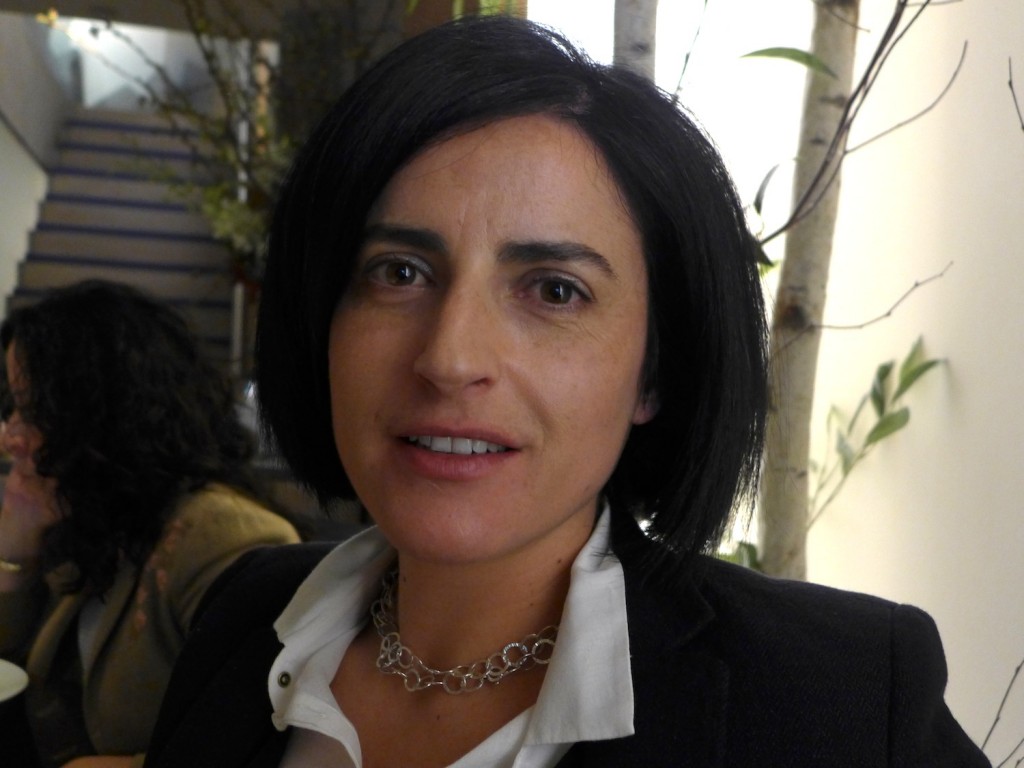 I spent the whole day yesterday running around Manhattan/NYWC from one wine tasting to the next (four in all) and on paper not one of them had anything to do with Riesling. First up was a tasting of the wines from the huge Esporao winery of Alentejo/Portugal. I couldn’t stay for the reds, but that didn’t matter because I’d already tasted all of them with chief winemaker David Baverstock last month in Berlin. It was a stroke of luck that Sandra Alves (above) was in NYWC representing the company, since she is the white winemaker and I only had time for the whites. Although a couple of the high-end whites from Esporao spend time in oak, most of their whites don’t. A perfect example of Sandra Alves’ work is the dry white 2011 ‘Duos Castas’, a blend of Semillon and the indigenous Viosinho grape (a native of the Douro Valley). It smelt of floral honey and orange blossom, tasting simultaneously quite richly textural and wonderfully fresh. All this was achieved only using stainless steel tanks and some stirring of the lees, just like many top dry Rieslings. Of course, due to the non-Riesling grape varieties the aromas are different, but even then they work in a way that is not fundamentally different from those of some dry Rieslings. Let’s say there is some kind of family resemblance.
I spent the whole day yesterday running around Manhattan/NYWC from one wine tasting to the next (four in all) and on paper not one of them had anything to do with Riesling. First up was a tasting of the wines from the huge Esporao winery of Alentejo/Portugal. I couldn’t stay for the reds, but that didn’t matter because I’d already tasted all of them with chief winemaker David Baverstock last month in Berlin. It was a stroke of luck that Sandra Alves (above) was in NYWC representing the company, since she is the white winemaker and I only had time for the whites. Although a couple of the high-end whites from Esporao spend time in oak, most of their whites don’t. A perfect example of Sandra Alves’ work is the dry white 2011 ‘Duos Castas’, a blend of Semillon and the indigenous Viosinho grape (a native of the Douro Valley). It smelt of floral honey and orange blossom, tasting simultaneously quite richly textural and wonderfully fresh. All this was achieved only using stainless steel tanks and some stirring of the lees, just like many top dry Rieslings. Of course, due to the non-Riesling grape varieties the aromas are different, but even then they work in a way that is not fundamentally different from those of some dry Rieslings. Let’s say there is some kind of family resemblance.
I could say much the same about the dry 2011 Tokaji from Château Dereszla in Tokaj/Hungary which I encountered right afterwards at the Midtown offices of importers Cognac One. Although about 10% of this wine was fermented and matured in oak, the fruity aromas of the Furmint and Muscat grapes dominated the oak completely, and the balance of 13% natural alcohol with just over 6 grams/liter acidity with 6 grams/liter residual sweetness (i.e. both around 0.6%) was entirely familiar to me from modern dry German Rieslings. However, this is probably a more flexible food wine than most high-end dry 2011 German Rieslings. Analytically they might not have more acidity, but generally they taste slightly more acidic, which makes food pairing more challenging.
 Next up was the German wine tasting at the Museum of Art & Design on Columbus Circle. This was a Riesling-free-zone due to the theme: Germany’s Pinot Trio. There I met Hans-Peter and Edeltraud Ziereisen from the eponymous winery in the extreme southwest of the Baden region (from many of their vineyards you can see both the Vosges Mountains of Alasce and Basel in Switzerland). Their 2010 Pinot Noirs have just been released and each of the four vineyard designates they showed tasted totally different, very much like Riesling from different vineyard sites but from the cellar of one top winegrower do. My favorite was the 2010 Rhini, which had a great black cherry and smoke bouquet, elegantly dry tannins and terrific concentration for a wine with just 12.3% natural alcohol.
Next up was the German wine tasting at the Museum of Art & Design on Columbus Circle. This was a Riesling-free-zone due to the theme: Germany’s Pinot Trio. There I met Hans-Peter and Edeltraud Ziereisen from the eponymous winery in the extreme southwest of the Baden region (from many of their vineyards you can see both the Vosges Mountains of Alasce and Basel in Switzerland). Their 2010 Pinot Noirs have just been released and each of the four vineyard designates they showed tasted totally different, very much like Riesling from different vineyard sites but from the cellar of one top winegrower do. My favorite was the 2010 Rhini, which had a great black cherry and smoke bouquet, elegantly dry tannins and terrific concentration for a wine with just 12.3% natural alcohol.
My final stop was the Spring Wine Tasting of Garnet Wines & Liquors. There I tasted the amazing 2010 ‘Orthogneiss’ Muscadet du Serve & Maine from Domaine de L’Ecu in the Loire Valley, which was as steely and austerely minerally as an uncompromising dry Riesling from a very cool region. However, the wine was made from the Melon grape that also gave the ocean of thin run-of-the-mill Muscadets which got this appellation a bad name. I’m not a Sauvignon Blanc fan, but the 2010 Reuilly (a 100% Sauvignon Blanc also from the Loire Valley) from Domaine Dyckerhoff was also racy and minerally with only a hint of the green bell pepper aroma (technical name pyrazines) at the long finish. How does minerally actually taste? I describe it as a saltiness, most obvious in the aftertaste, but for more about this see the story directly below this post. These are sophisticated wines for $18.99 and $15.99 respectively, and if you like dry Riesling the chances are you’ll find them at least interesting, and possibly as exciting as I did.

![120114_riesling_global_RZ [1600x1200]](http://www.stuartpigott.de/wp-content/uploads/2013/03/120114_riesling_global_RZ-1600x12006.jpg)